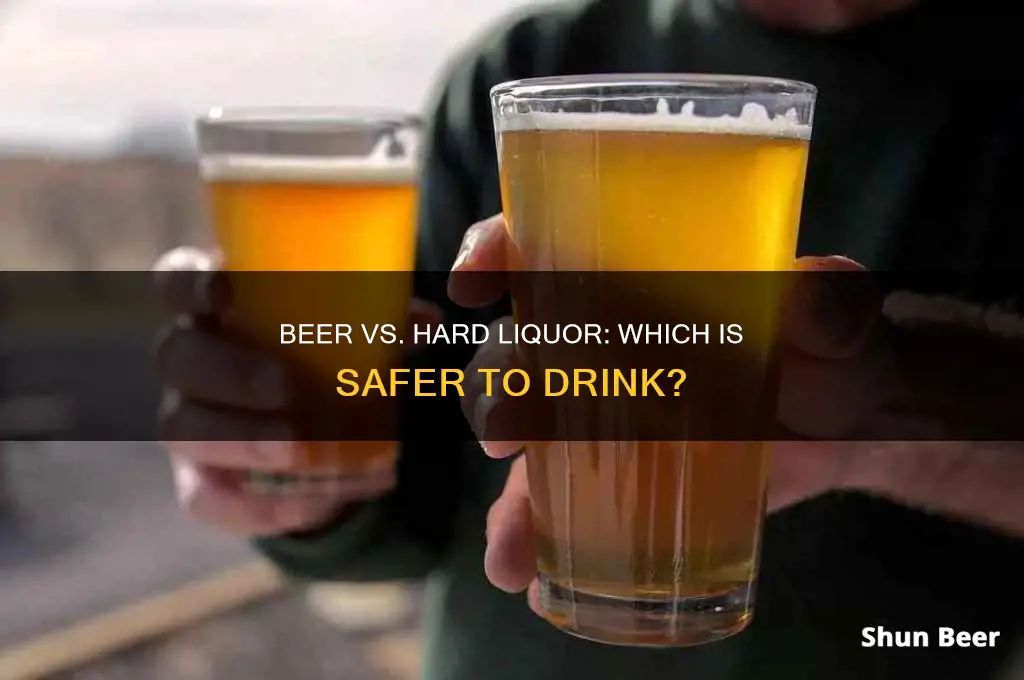
Alcohol is a depressant that affects the central nervous system and impairs a person's judgment and behavior. Beer and hard liquor are popular alcoholic beverages with distinct characteristics and effects on the body. Beer typically has a lower alcohol content compared to hard liquor, with beer ranging from 4-6% ABV and liquor ranging from 40-50% ABV. This means that it takes much less hard liquor to cause the same effects as a mug of beer, leading to quicker intoxication and potential harm. Both beer and liquor can contribute to various health risks, including heart disease and liver damage, especially with excessive alcohol use.
| Characteristics | Values |
|---|---|
| Alcohol by volume (ABV) | Beer: 4-6% |
| Liquor: 40-50% | |
| Serving size | Beer: 12 ounces |
| Liquor: 1.5 ounces | |
| Calories | Beer: Higher |
| Carbohydrates | Beer: More |
| Liquor: Often zero | |
| Antioxidants | Beer: More |
| Health benefits | Beer and liquor: Similar, but only in moderation |
| Health risks | Beer and liquor: Heart disease, liver damage, cancers |
| Addiction risk | Beer and liquor: Both addictive |
| Liquor: Higher risk due to higher alcohol content |
What You'll Learn

Beer has more antioxidants, but liquor has fewer carbs
Beer and liquor are popular alcoholic drinks with distinct characteristics and effects on the body. While beer has more antioxidants, liquor typically has fewer carbohydrates.
Beer contains phenolic compounds, or antioxidants, originating mostly from barley malt, with the rest contributed by hops. These antioxidants provide small health benefits, but it's important to note that excessive alcohol consumption can lead to serious health issues.
Liquor, also called hard liquor or distilled spirits, is produced by distilling grains, vegetables, or fruits. Vodka, rum, whiskey, gin, and tequila in their pure form have no carbohydrates, which is beneficial for keeping blood sugar levels stable. However, when combined with sugary mixers like juice or soda, the calorie and carbohydrate intake increases.
Both beer and liquor can contribute to various health risks, especially with excessive consumption. These risks include heart disease, liver damage, and weight gain due to higher caloric content. Additionally, alcohol use, especially in excessive amounts, is associated with an increased risk of certain cancers, including breast cancer and cancers of the liver, esophagus, colon, rectum, and larynx.
It's crucial to remember that the idea of health benefits from alcoholic drinks is complicated. While moderate drinking may offer some benefits, excessive consumption can lead to serious health issues and addiction. Responsible drinking and moderation are essential for minimizing negative impacts.
Americans' Beer Consumption: How Much is Too Much?
You may want to see also

Beer and liquor have similar health benefits
While beer and liquor have different alcohol content, they have similar health benefits when consumed in moderation.
Beer and liquor are popular alcoholic beverages with distinct characteristics and effects on the body. Beer typically has an alcohol by volume (ABV) of 4-6%, while liquor ranges from 40-50% ABV. Despite these differences, beer and liquor have comparable health benefits when consumed in moderation.
Beer contains phenolic compounds, or antioxidants, originating mostly from barley malt and hops. Liquor, on the other hand, often has fewer or no carbohydrates, with vodka, rum, whiskey, gin, and tequila in their pure form containing zero carbohydrates.
According to the Harvard T.H. Chan School of Public Health, ethanol is the form of alcohol that provides most of the health benefits from alcoholic beverages. Both beer and liquor contain ethanol, and in moderation, they can offer similar health benefits.
A study of 38,000 men over 12 years observed that moderate drinkers were 35% less likely to have a heart attack than non-drinkers. This observation held for both beer and liquor consumption. Similarly, a study in the American Journal of Public Health showed that women who drank one drink per day over four days had a lower risk of mortality than those who drank the same amount in one or two days, regardless of the type of alcohol.
However, it is important to note that excessive alcohol consumption is associated with various health risks, including liver damage, heart disease, and an increased risk of certain cancers. Therefore, moderation is key to reaping any potential health benefits from beer or liquor consumption.
Beer and Conception: What You Need to Know
You may want to see also

Liquor is stronger than beer
It is important to note that alcohol is fundamentally the same whether it is found in beer or liquor. However, liquor is stronger than beer in terms of alcohol content. A bottle of liquor can have nearly 40% more alcohol by volume than a can of beer. The standard measure of alcohol content is known as Alcohol by Volume (ABV). Typically, beer has an ABV of 4-6%, while liquor ranges from 40-50%. This means that it takes much less hard liquor to cause the same effects as a glass of beer, leading to intoxication far more quickly.
Liquor is also often served in the form of cocktails, which can mask the taste of the alcohol and cause people to consume more than they would otherwise. People also tend to down shots of liquor more quickly, and multiple shots can be consumed in a matter of minutes. In contrast, it usually takes beer drinkers a few hours to consume the same amount of alcohol.
The higher alcohol concentration in liquor also results in more rapid and intense intoxication and more severe hangovers. This is because liquor causes more dehydration and a greater buildup of toxins in the body.
While liquor has a higher alcohol content, it often has fewer or no carbohydrates. Beer, on the other hand, contains phenolic compounds, which are antioxidants. However, the overall health effect of these antioxidants is small, and both beer and liquor provide roughly the same health benefits when consumed in moderation.
Alcohol and Breastfeeding: Is Drinking Wine or Beer Safe?
You may want to see also

Liquor is often masked in larger drinks
It is important to note that liquor is often masked in larger drinks, such as cocktails or long drinks. This means that people may consume more liquor than they realise, as the taste is often hidden by other ingredients. This can lead to quicker intoxication and potential harm.
Liquor, also called hard liquor or distilled spirits, is produced by distilling grains, vegetables, or fruits. It has a higher alcohol content than beer, typically ranging from 40-50% alcohol by volume (ABV). A standard serving of liquor is usually 1.5 ounces, often in the form of a shot. Despite the smaller serving size compared to beer, the higher alcohol concentration in liquor results in faster and more intense intoxication.
Cocktails, which are a common way to consume liquor, often contain non-alcoholic mixers and ingredients that give the drink a unique flavour. These mixers can include soda, juice, or other sugary substances. While these additions may improve the taste of the drink, they can also significantly increase the number of calories and carbohydrates consumed.
It is crucial to be aware of the risks associated with drinking spirits. The higher alcohol content of liquor can lead to quicker intoxication and potential harm if consumed in large quantities. Additionally, the masking effect of mixers can cause people to consume more liquor than they realise. Responsible drinking and moderation are essential to minimise the negative impacts of alcohol consumption.
Overall, while beer and liquor have some similarities, it is important to recognise that liquor is often masked in larger drinks, which can have significant effects on the body. Understanding the differences between these alcoholic beverages and practising moderation are key to maintaining a healthy lifestyle.
Drinking Alcohol with Montelukast: What You Need to Know
You may want to see also

Beer and liquor can both lead to liver damage
Alcoholic beverages, including beer and liquor, contain the recreational drug ethanol. While beer has more antioxidants than hard liquor, the overall health effect is small. Ethanol provides most of the health benefits from alcoholic drinks, as long as they are consumed in moderation. However, alcohol is toxic to the liver, and prolonged alcohol abuse can damage this vital organ, regardless of the type of drink.
Each time the liver filters alcohol, some liver cells die. The liver can usually regenerate itself and make new cells, but heavy drinking over many years can reduce its ability to regenerate. This can result in serious and permanent damage to the liver. Alcohol-related liver disease (ARLD) refers to liver damage caused by excess alcohol intake and has several stages of severity.
Drinking a large amount of alcohol, even for just a few days, can lead to a build-up of fats in the liver, known as alcoholic fatty liver disease. This is the first stage of ARLD and can be reversible if the person stops drinking. However, if drinking continues, it can progress to alcoholic hepatitis, where the liver becomes inflamed and swollen, and liver cells are destroyed. This can be life-threatening and often requires the person to stop drinking entirely to prevent further damage and increase life expectancy.
The final stage of ARLD is cirrhosis, where the liver has become significantly scarred. This stage is generally irreversible, and a person with alcohol-related cirrhosis who doesn't stop drinking has a less than 50% chance of living for at least five more years. A liver transplant may be required in severe cases, but this is only considered if the person has stopped drinking.
The symptoms of ARLD include yellowing of the eyes and skin (jaundice), swelling in the ankles and abdomen, confusion or drowsiness, and vomiting blood or passing blood in stools. ARLD is often only diagnosed during tests for other conditions or when the liver is already severely damaged. Therefore, it is important to be aware of the risks associated with drinking alcohol and to seek medical advice if concerned about alcohol consumption.
Celebrating National Drink a Beer Day in September
You may want to see also
Frequently asked questions
Beer has more antioxidants than hard liquor, but the overall effect is small. Beer also contains carbohydrates, while hard liquor does not. However, hard liquor is much stronger than beer and can lead to quicker intoxication and potential harm.
Both beer and hard liquor can contribute to various health risks, including heart disease and liver damage, especially with excessive alcohol use. Alcohol addiction is a serious risk, and it can occur with any type of alcoholic beverage.
Moderate drinking is defined as up to one drink per day for women and up to two drinks per day for men. A standard beer is typically 12 ounces with 5% alcohol content, while a serving of hard liquor is 1.5 ounces with 40% alcohol content.







